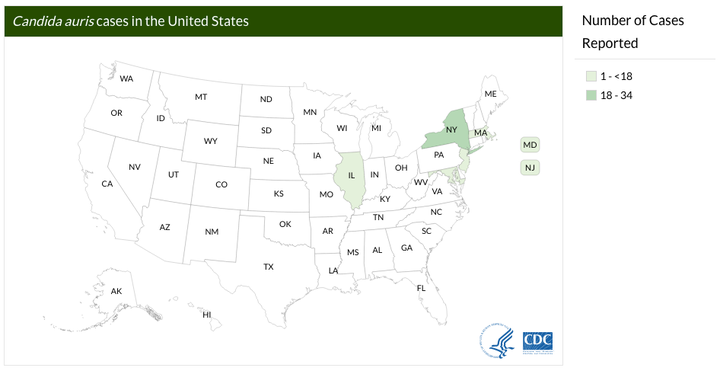A drug-resistant fungus that first emerged in the U.S. only a few years ago has continued to pop up throughout healthcare facilities across the country.
C. auris, a yeast that has sickened people around the globe and is linked to occasionally fatal infections, appears to have arrived in the U.S. around 2013, according to the first report on C. auris released by the CDC back in November.
Between August 2016 and March 2017, the number of C. auris cases rose almost seven-fold, from seven cases to 53, according to a new monthly report from the U.S. Centers for Disease Control and Prevention. That case count doesn’t include 27 additional patients whose test results showed the presence of C. auris, but did not have symptoms of an infection.
This jump in cases may be because of spreading infection, or it may be because of better reporting: The CDC asked all U.S. clinics, labs and public health authorities to start collecting information about any potential cases of C. auris in June.
Of the original seven cases that the CDC first reported on in November, four of them died weeks or months after the yeast was identified. All had bloodstream infections of C. auris, but the CDC notes that in general, people with these infections also had serious underlying medical conditions that may have also contributed to their death.

While these U.S. cases have been confined to hospital-linked infections and aren’t circulating in the community, public health experts are worried that it could grow into a major threat. There are only three classes of medications that can cure fungal infections, and there have been cases of C. auris in other countries that have resisted all three treatments.
“When you’re dealing with a multidrug resistant pathogen that we know is causing a lot of disease in countries where it is more widespread, then we worry about it causing similar problems in the United States,” said Dr. Tom Chiller, chief of CDC’s Mycotic Diseases Branch, back in November. “We feel we need to take it very seriously, be aggressive and get out in front and try to see what we can do to prevent its spread.”
Here’s what you should know about the C. auris fungus.
1. All the U.S. cases are linked to a healthcare setting
The cases of C. auris occurred in healthcare facilities in New York, Illinois, Maryland, Massachusetts and New Jersey and struck hospitalized patients with other underlying medical conditions.
Five of the first seven cases identified in the Nov. 2016 report were resistant to at least one antifungal medication, but unlike strains from other parts of the globe, they were not resistant to all three classes of antifungal drugs doctors have at their disposal.
While the fungal strains were genetically related to strains isolated in South Asia and South America, none of the original seven patients who had C. auris infections had ties or had traveled to those regions, the CDC noted back in November, which means they were probably infected locally.
2. C. auris is relatively new, and mostly affects severely sick people.
C. auris was first isolated in 2009 in Japan and was so-named because it came from the discharge in a patient’s ear canal (auris means ear in Latin). It has since shown up in South Korea, India, Pakistan, South Africa, Kenya, Kuwait, Israel, Venezuela, Colombia, the United Kingdom and Canada. It can cause serious bloodstream, wound and ear infections, and has struck patients of all ages.
Based on the limited information researchers have gathered on these cases so far, researchers have observed that 60 percent of people with C. auris infections have died, but it’s unclear what, exactly, caused them to die, as people who get this infection are already severely ill.
Risk factors for C. auris infection include surgery, diabetes, the use of antibiotic and antifungal treatments, and use of a central line catheter in the arm or chest.
3. How to protect yourself from drug-resistant microbes
If you’re a patient in the hospital, one way to protect yourself from drug-resistant microbes is by asking everyone who enters your room to wash their hands. If you have a catheter in place, you should also ask your healthcare provider every day if that catheter is necessary, advises the CDC.
Scientists are generally most concerned about antibiotic-resistant bacteria, which is the biggest group of drug-resistant microbes. About two million people will get infected with an antibiotic-resistant bacterium every year in the U.S., while an estimated 23,000 people will die of their infection.
There is no national mandatory reporting for antifungal-resistant infections, so the CDC doesn’t have comparable figures, Chiller explained. But in a report outlining the most concerning drug-resistant pathogens, other species of Candida yeasts resistant to the anti-fungal medication fluconazole are characterized as a “serious” threat because it’s the fourth-most common cause of healthcare-linked bloodstream infections in the U.S.
This article was updated from a Nov. 2016 story on C. auris.
